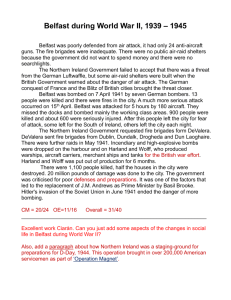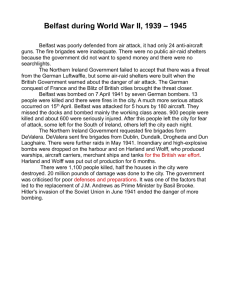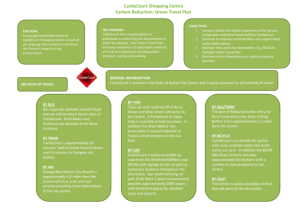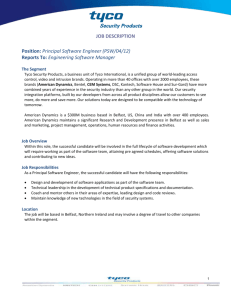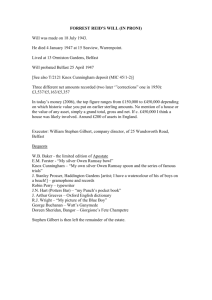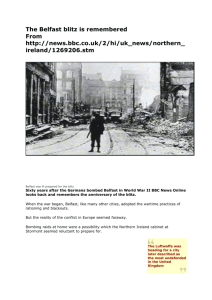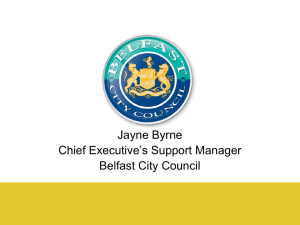File - Mountrath CS History
advertisement
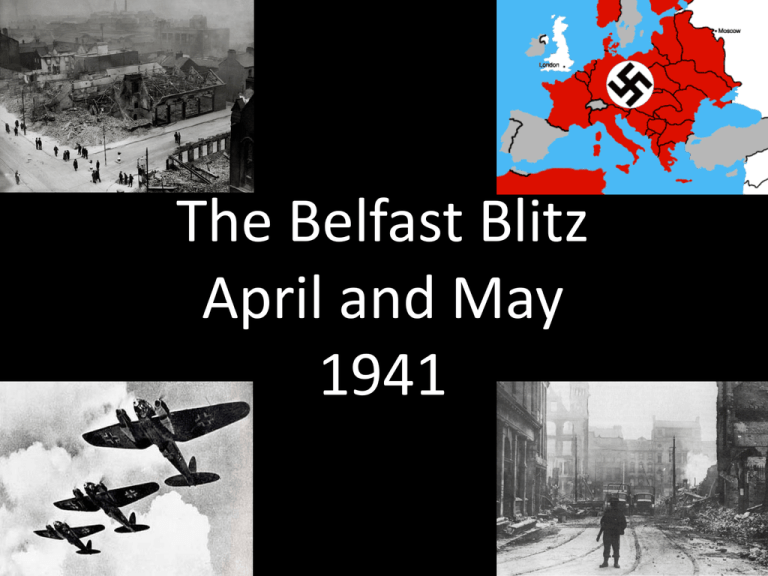
The Belfast Blitz April and May 1941 Learning Intentions The Belfast Blitz In this presentation you will find out: 1.What does the word Blitz mean? 2.When did the attacks on Belfast take place? 3.Why was Belfast attacked? 4.What were the results of the Belfast Blitz? Thinking Skills and personal capabilities • Managing information • Thinking • Problem solving • Decision making Key Words • • • • • • • • • • Blitz Blitzkrieg Anti-aircraft guns Search Lights Barrage Balloons Night Fighters ARP Wardens Public/Private shelters Gasmasks Evacuation Setting the Scene • Hitler’s Blitzkrieg sweeps through Europe 1939-1940 Why did Belfast Ignore the threat of attack? • The N.I Government believed Belfast was too far away for attack. “An attack on N. Ireland would involve a flight of over 1,000 miles. For Aeroplanes of the bombing type, loaded, this si a very big undertaking and the enemy airplanes must twice pass through the active gun, searchlight and aeroplane defences of Great Britain and it is possible we might escape attack.” (Edmund Warnock, Parliamentary Secretary at the Ministry of Home Affairs) Why was Belfast an important target for the Germans? • Harland & Wolff – Tonnage of shipping built, largest of any in the world • Warships – Aircraft Carriers, Corvettes, Merchant ships and ship repairs • 500 Churchills • Short & Harland – Stirling bombers, Sunderland Flying Boats • Mackies & Ropeworks In what way was Belfast badly prepared defensively? • By 1941 Belfast had still not been affected by the war even though it had begun 20 months earlier (September 1939) • The reaction in N. Ireland did not compare well to the comprehensive evacuation and air raid protection schemes implemented in Britain • As a result Belfast was the least prepared city in the UK Facts • • • • • • • • Anti-aircraft Guns Searchlights Barrage Balloons Night Fighters ARP Wardens Public/Private Shelters Gasmasks Evacuation The Belfast Blitz The First Attack! The Dockside Raid 7th – 8th April 1941 The Dockside raid • Moon half full, winds light and visibility good • The raid began after midnight and lasted three and a half hours • The first raid was an exploratory raid and was used to test Belfast’s Defences and unnerve the population The Luftwaffe • The Luftwaffe had been tried and tested across Europe (From Spain in 1936 to France in 1940) and up until the Battle of Britain was regarded as the best in the world • They took off from Northern France and flew along the coast of Ireland until reaching their target, Belfast • They could not believe the scant defences around the city Attack! • The Luftwaffe simply disregarded local anti-aircraft guns and attacked just above the barrage balloons • The defence was that weak that the German planes even kept their navigation lights on • In East Belfast, the Newtownards Road, Templemore Avenue and Alberbridge Road were badly damaged • It is said that in this area “incendiary bombs rained down like hailstones and flames spouting up everywhere” The Belfast Blitz What was happening in Belfast on Easter Tuesday 1941? Easter Tuesday 1941 • Families visit the Zoo • Bangor and back for a “bob” • Big match at Windsor: Linfield vs Distillery • Dancing at the Floral Hall The Second Raid Easter Tuesday Night – Mild, Bright, ¾ Moon • 180 German bombers took off from airfields in Northern France • At 10.40 pm local time sirens went off around the city • People ran for cover wherever they could get it • Trams stopped running • 10.45 pm Parachute flares light the streets of Belfast The Impact of the second raid • • • • • • • The raid lasted for 5 hours 30,000 incendiaries dropped 700 high explosive bombs 200 tons of explosives & parachute land mines Houss collapsed like packs of cards The hardest hit was North and West Belfast Contd… The Impact of the second raid • • • • • • • Cavehill, Crumlin and Antrim Road devastated Victoria Barracks destroyed York St Mill severely damaged Air raid shelter in Percy St collapses killing 30 40 workers in Harland & Wolff killed Telephone exchange at Oxford St. destroyed Contd… The Impact of the second raid • Communications damage leads to Anti-aircraft operation ceasing • Lines to Great Britain destroyed • Message sent to Dublin leads to 13 fire appliances and 70 crew helping Belfast • 4.55 am the all clear siren was sounded • The number of dead listed at the time was 858 people killed Evacuation • Over the next few days people fled the city • By the end of the month 100,000 had left Belfast • The people frightened of the Luftwaffe returning moved to the hills of Castlereagh, Gilnahirk, Glenglrmley and Cavehill The Aftermath • The 858 killed was the highest number of fatalities in any single raid outside of London • The dead were collected in ambulances, coal lorries, furniture vans • Temporary mortuaries were established at the Falls Road and St Peter’s Hill baths • Unclaimed bodies were taken to St George’s Market and onto to common graves in Milltown and City Cemeteries • Thousands of mourners lined the route Sunday 4th May 1941 • • • • Cloudless Night – Full Moon 12.47 am – 204 enemy aircraft attack Belfast Accurate bombing began 96,000 incendiaries and 237 tons of explosives dropped • ARP wardens report widespread panic Continued Devastation • “Huge crowds of panic-stricken people rushing from damaged terraces, often leaving relations, friends or neighbours buried, wounded or dead lying in the debris.” • The residential area of East Belfast, Ballymacarret to Syndenham suffered the most • At least half of the houses here were destroyed Continued Devastation • Damage caused to water mains led to fire spreading unchecked • City centre heavily damaged • High explosives and incendiaries rained down on Shaftesbury Square, The City Hall, Bedford St., Chicester St., Donegall Place, Castle Place, Castle St., High St., Victoria St. • Some of Belfast’s finest streets were reduced to smouldering ashes – Rosemary, High, Waring, North and Bridge Streets Continued Devastation • During the raid a number of Belfast’s most attractive buildings were destroyed or severely damaged – Rosemary St Presbyterian Church, The Banqueting Hall in the City Hall and the Belfast water commissioners office • York St Mill was hit again with “Flames coming from every window” • The fires in Belfast could be seen from Bangor, Lisburn and the Glenshane Pass Aftermath • The all clear was sounded at 5.15 am • That morning, without trams or trolley buses, people walked to work, crowding the footpaths • The condition of Belfast was such that people who had lived there all their lives lost their way. They passed smoking ruins of barely recognisable buildings. May citizens were crying when they saw the devastation • In this raid 191 people were killed, half of them women and children Aftermath • East Belfast and City centre destroyed • 2 out of 3 workshops in Harland & Wolff destroyed • Short & Harland aircraft factory hit, widespread damage • 3 months of production was lost The Final Raid 5/6th May 1941 • On this night at 12.45 am a small raid of about 3 aircraft dropped incendiary bombs and high explosives on East Belfast • At 2 am, 2 public shelters were destroyed, killing 14 people and injuring 40 • 300 people from Ravenscroft Avenue were made homeless Stray Aircraft • It is almost certain that this raid was carried out by ‘stray aircraft’ taking part in a raid on Glasgow and possibly attracted by the fires still burning in Belfast from the night before Aftermath • • • • • The raids in April and May were terrible 56,000 houses were damaged or destroyed Half the city’s housing was affected 100,000 people were made homeless Belfast’s industrial infrastructure suffered extensively, delaying production for six months • The total killed was in excess of 1,100 civilians Irish Times headlines The gravestone erected at Milltown Cemetery, Belfast, in memory of the unidentified victims of the 15-16 April raid in 1941 (Ulster Museum)

